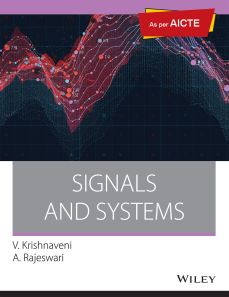Signals and Systems, As per AICTE
ISBN: 9788126509829
664 pages
Publication Year: 2019
For more information write to us at: acadmktg@wiley.com

Description
The term “signals and systems” are used broadly in diverse fields that have applications in a broad class of problems including communications, VLSI circuit design, acoustics, aeronautics, biomedical engineering, speech processing, radar system design, pattern recognition and multimedia technology. The subject is a core text for students of circuit. An in-depth knowledge in this subject is mandatory to understand various subjects such as digital signal processing, digital image processing, speech signal processing, VLSI signal processing and radar signal processing. This book focuses on the concepts of signals, different types of signals, an introduction to systems theory, system analysis, etc. Also, this book looks at the way that signals interact with physical systems.
Preface
- Introduction to Signals and Systems
- Introduction
- Signals
- Systems
- Classification of Signals
- Classification of Systems
- Continuous-Time and Discrete-Time Signals
- Introduction
- Signals Operations
- Basic Signals
- Classification of Continuous-Time and Discrete-Time Signals
- Continuous-Time and Discrete-Time Systems
3.1 Introduction
3.2 Interconnection of Systems
3.3 Properties of Systems
- Linear Time-Invariant Systems
4.1 Introduction
4.2 Response of DT LTI Systems: The Convolution Sum
4.3 Response of CT-LTI Systems: The Convolution Integral
4.4 Properties of LTI Systems
- Fourier Analysis of Continuous-Time Signals and Systems
5.1 Introduction
5.2 Response of LTI Systems to Complex Exponentials
5.3 Fourier Representations for Four Types of Signals
5.4 Fourier Series Representation of CT Periodic Signals: CTFS
5.5 Magnitude and Phase Spectra of Periodic Signals
5.6 Determining the Fourier Series Coefficients ak: CTFS Analysis Equation
5.7 Convergence of CTFS
5.8 Gibb’s Phenomenon
5.9 Properties of CTFS
5.10 Application of Fourier Series
5.11 Representation of CT Aperiodic Signal: CTFT
5.12 Convergence of CTFT
5.13 Fourier Transform for Periodic Signals
5.14 Properties of CTFT
5.15 LTI-CT Systems Characterized by Linear Constant Coefficient Differential Equations
- Sampling
- Introduction
- Representation of CT Signal by Its Samples
- Impulse Train Sampling
- Zero-Order Hold Sampling
- Relationship between Analog Frequency (W) and Digital Frequency (ω)
- Quantization
- Encoding of Quantized Samples
- A Complete DSP System
- Fourier Analysis of Discrete-Time Signals and Systems
7.1 Introduction
7.2 Response of DT-LTI Systems to Complex Exponentials
7.3 Fourier Series Representation of DT Periodic Signals: DTFS
7.4 Magnitude and Phase Spectrum of DT Periodic Signals
7.5 Determination of Fourier Series Coefficients ak: DTFS Analysis Equation
7.6 Convergence of Issues in DTFS
7.7 Properties of DTFS
7.8 Application of DTFS
7.9 Representation of DT Aperiodic Signals: DTFT
7.10 Convergence of DTFT
7.11 Fourier Transform for Periodic Signals
7.12 Properties of DTFT
7.13 LTI-DT Systems Characterized by Linear Constant Coefficient Difference Equations
- Laplace Transform
- Introduction
- Laplace Transform of CT Signals
- Relationship between CTFT and Laplace Transform
- Properties of ROC for Laplace Transforms
- Properties of Laplace Transform
- Inverse Laplace Transform
- Analysis of LTI Systems by using Laplace Transform
- Solving Differential Equations by using Laplace Transform
- Unilateral Laplace Transform
- z-Transform
- Introduction
- z-Transform of DT Signals
- z-Transform and ROC of Finite-Duration Sequences
- z-Transform and ROC of Infinite-Duration Sequences
- Relationship between DTFT and z-Transform
- Properties of Region of Convergence
- Properties of z-Transform
- Inverse z-Transform
- Analysis of LTI Systems by using z-Transform
- Unilateral z-Transform
Answers
Appendix A
Appendix B
Index

